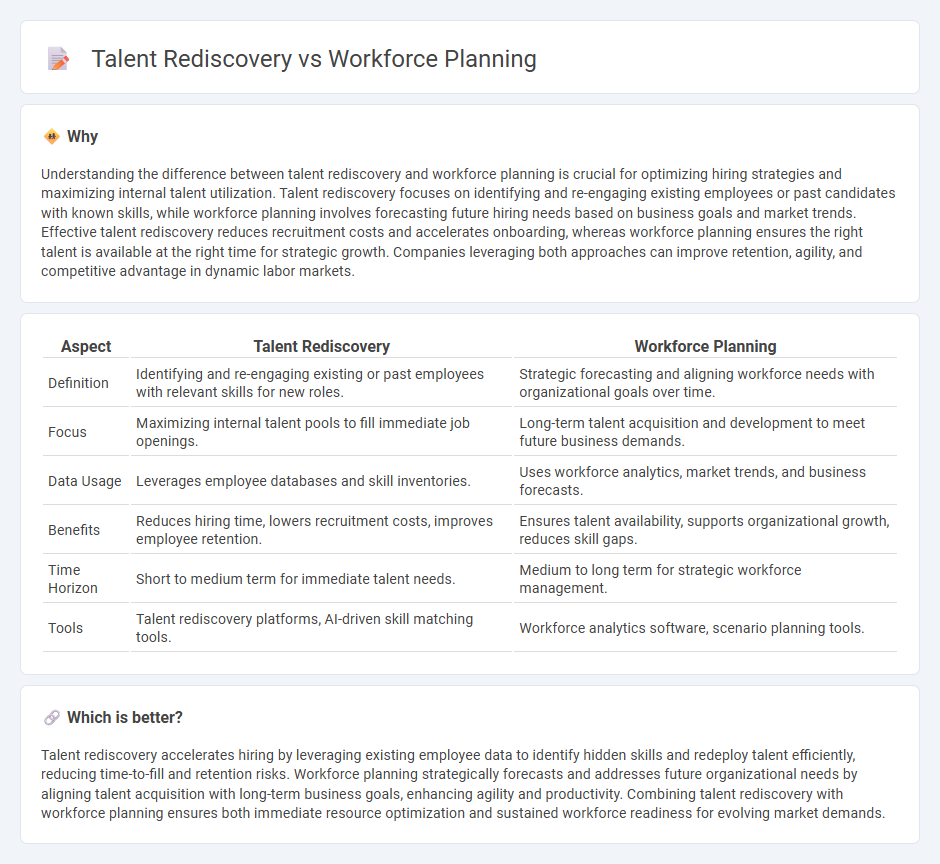
Talent rediscovery leverages existing employee skills and past candidate data to fill roles efficiently, reducing recruitment costs and accelerating hiring timelines. Workforce planning involves strategic forecasting of future labor needs, aligning workforce capabilities with organizational goals through data-driven analysis. Explore how integrating talent rediscovery with workforce planning optimizes talent acquisition and retention strategies.
Why it is important
Understanding the difference between talent rediscovery and workforce planning is crucial for optimizing hiring strategies and maximizing internal talent utilization. Talent rediscovery focuses on identifying and re-engaging existing employees or past candidates with known skills, while workforce planning involves forecasting future hiring needs based on business goals and market trends. Effective talent rediscovery reduces recruitment costs and accelerates onboarding, whereas workforce planning ensures the right talent is available at the right time for strategic growth. Companies leveraging both approaches can improve retention, agility, and competitive advantage in dynamic labor markets.
Comparison Table
| Aspect | Talent Rediscovery | Workforce Planning |
|---|---|---|
| Definition | Identifying and re-engaging existing or past employees with relevant skills for new roles. | Strategic forecasting and aligning workforce needs with organizational goals over time. |
| Focus | Maximizing internal talent pools to fill immediate job openings. | Long-term talent acquisition and development to meet future business demands. |
| Data Usage | Leverages employee databases and skill inventories. | Uses workforce analytics, market trends, and business forecasts. |
| Benefits | Reduces hiring time, lowers recruitment costs, improves employee retention. | Ensures talent availability, supports organizational growth, reduces skill gaps. |
| Time Horizon | Short to medium term for immediate talent needs. | Medium to long term for strategic workforce management. |
| Tools | Talent rediscovery platforms, AI-driven skill matching tools. | Workforce analytics software, scenario planning tools. |
Which is better?
Talent rediscovery accelerates hiring by leveraging existing employee data to identify hidden skills and redeploy talent efficiently, reducing time-to-fill and retention risks. Workforce planning strategically forecasts and addresses future organizational needs by aligning talent acquisition with long-term business goals, enhancing agility and productivity. Combining talent rediscovery with workforce planning ensures both immediate resource optimization and sustained workforce readiness for evolving market demands.
Connection
Talent rediscovery enhances workforce planning by identifying existing employees' untapped skills and potential, enabling organizations to allocate resources more efficiently. Effective workforce planning leverages this insight to fill skill gaps and optimize talent deployment, reducing recruitment costs and improving retention rates. This integrated approach ensures a dynamic, adaptable workforce aligned with strategic business goals.
Key Terms
**Workforce Planning:**
Workforce planning involves analyzing current workforce capabilities, forecasting future talent needs, and developing strategies to align human resources with organizational goals. It focuses on optimizing talent acquisition, skill development, and succession planning to ensure business continuity and agility in a competitive market. Explore more to understand how effective workforce planning drives sustainable organizational growth.
Succession Planning
Workforce planning involves forecasting future staffing needs and aligning talent acquisition strategies to meet organizational goals, while talent rediscovery focuses on identifying and leveraging existing internal candidates for key roles. Succession planning serves as a critical component, ensuring leadership continuity by systematically preparing high-potential employees to fill vital positions. Explore more about integrating workforce planning and talent rediscovery to enhance effective succession planning.
Skills Gap Analysis
Workforce planning involves forecasting and strategizing to meet an organization's future staffing needs, emphasizing skill gap analysis to align current capabilities with business objectives. Talent rediscovery focuses on re-evaluating existing employee databases to identify hidden or underutilized skills that can fill these gaps efficiently. Explore how integrating these approaches can optimize resource allocation and strengthen your team's competencies.
Source and External Links
What Is Workforce Planning? Strategies and Benefits - Paychex - Workforce planning is the process of analyzing an organization's future staffing needs and developing strategies to meet those requirements through assessing the current workforce, forecasting future needs, identifying gaps, developing action plans, and ongoing evaluation.
Workforce Planning: Definition, Process and Principles | Indeed.com - Workforce planning involves analyzing, forecasting, and planning workforce supply and demand by determining strategic direction, conducting supply and demand analyses, and aligning talent needs with business goals.
Workforce Planning - NIH: Office of Human Resources - Workforce planning ensures an organization has the right people with the right skills at the right time by forecasting demand and supply, assessing gaps, implementing talent management actions, and monitoring results to meet strategic objectives.
 dowidth.com
dowidth.com